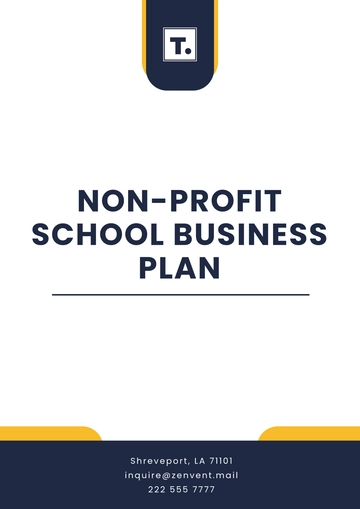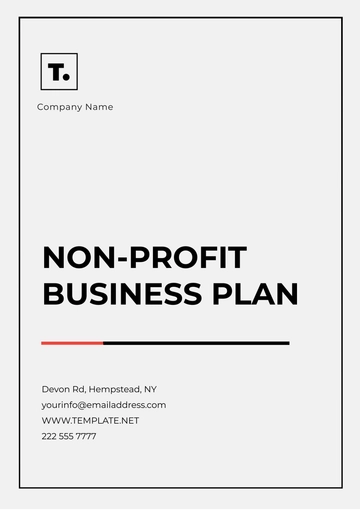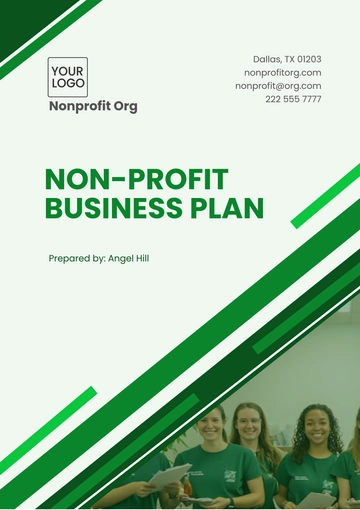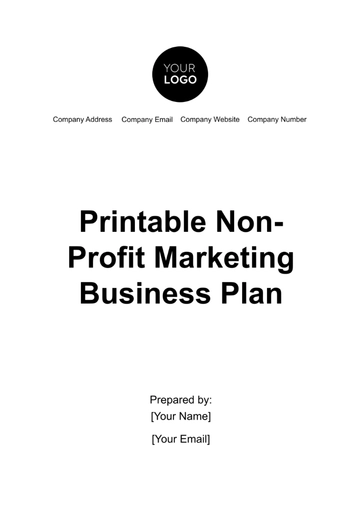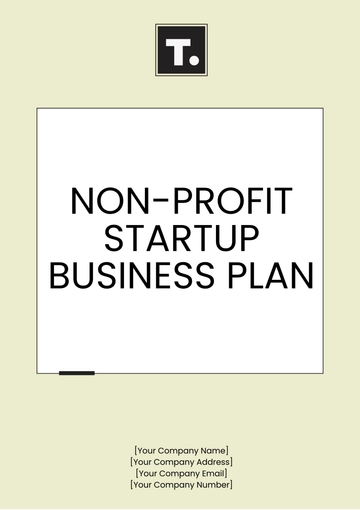Free Nonprofit 5-Year Plan Business Plan Design
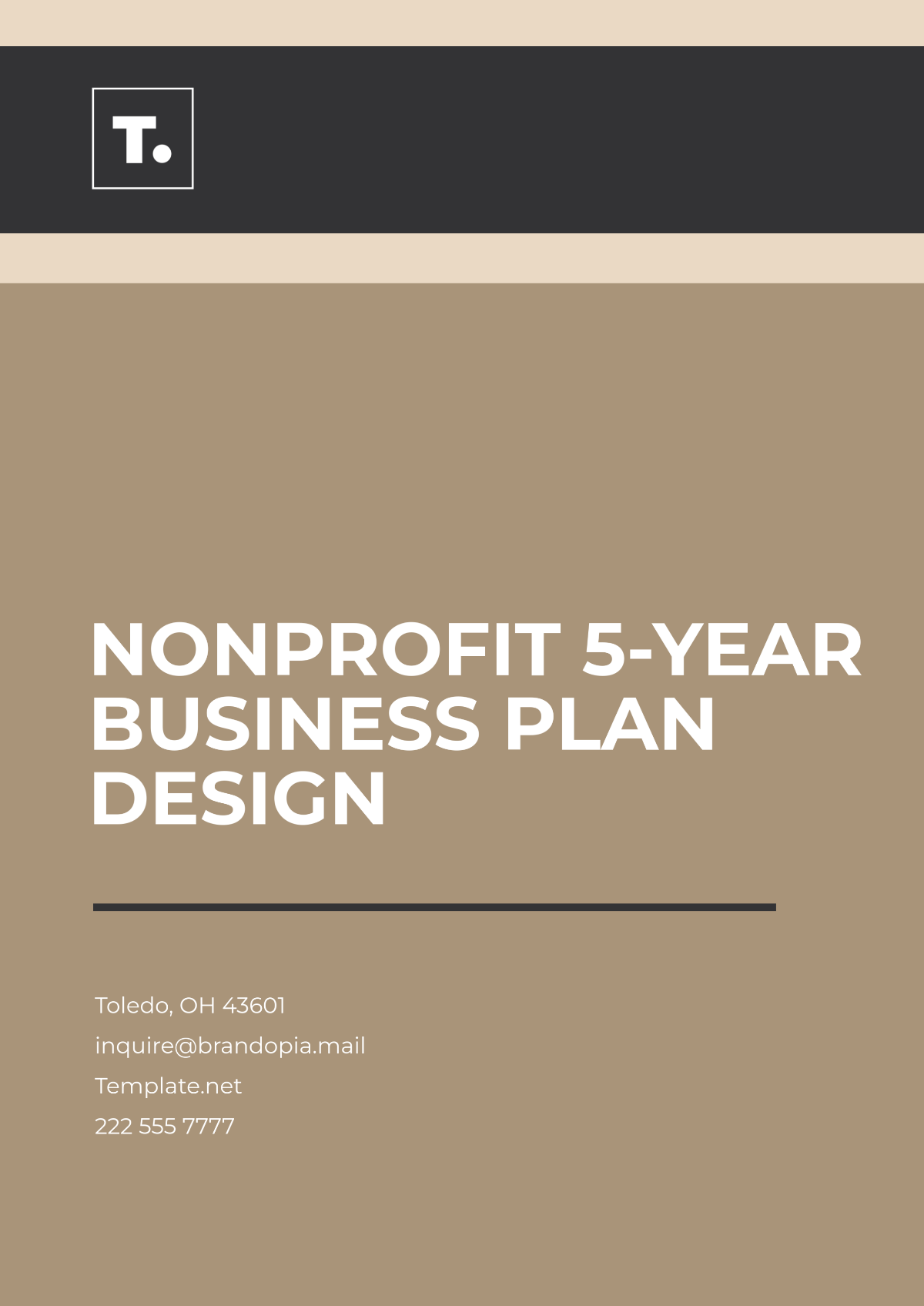
Prepared By: [Your Name]
Date: June 12, 2060
1. Executive Summary
The Empowering Communities Foundation aims to create lasting change in underserved communities by providing educational resources, workforce training, and health services. Over the next five years, we plan to expand our reach, diversify funding, and implement innovative community programs to empower individuals to break the cycle of poverty. Our nonprofit's goals include expanding services to 10 new communities, increasing annual funding by 50%, and engaging 500 volunteers by 2065. We will invest in technology and training to enhance our operational efficiency and program effectiveness.
2. Mission and Vision Statements
Mission Statement (2060):
Our mission is to empower individuals in underserved communities by providing education, job training, and healthcare services that enable them to achieve sustainable self-sufficiency. We strive to uplift lives by fostering opportunities that promote long-term success and well-being.Vision Statement (2060):
We envision a world where every individual, regardless of their background or circumstances, has access to the resources and support they need to lead a fulfilling, prosperous life. Our long-term vision is to eliminate barriers to education and opportunity, creating a society where every community thrives.
3. SWOT Analysis
Strengths:
Strong local presence with established partnerships in [regions or cities].
Comprehensive programs that address critical needs: education, healthcare, and employment.
A committed leadership team and board of directors with decades of experience in nonprofit management.
Weaknesses:
Reliance on a limited number of large donors creates financial uncertainty.
Limited ability to scale programs quickly due to volunteer-driven operations.
Underutilized digital marketing platforms, which restrict outreach potential.
Opportunities:
Expansion into rural areas and underserved urban communities to meet demand for services.
Rising interest in corporate social responsibility, creating opportunities for partnerships with businesses.
Growing interest in tech-based training programs and digital literacy, which can be integrated into our offerings.
Threats:
Potential cuts in government funding for community programs.
Economic downturns that could affect donor giving.
Increased competition from other nonprofits in the education and healthcare sectors.
4. Goals and Objectives
A. Five-Year Goal (2060-2065):
Expand service delivery to 10 new communities across [specific states/regions].
Achieve a 50% increase in annual revenue by 2065, diversifying funding sources.
Engage over 500 volunteers annually to support program initiatives.
Implement a digital learning platform that serves at least 1,000 individuals by 2065.
B. Yearly Objectives:
2061:
Launch a new educational program for high school dropouts in [Target Area].
Raise $500,000 through an online fundraising campaign.
2062:
Expand into two new cities (e.g., Dallas and Miami).
Partner with local businesses for workforce training programs and job placement initiatives.
2063:
Secure a multi-year grant from a major foundation.
Achieve a 40% increase in volunteer engagement by offering training and incentives.
2064:
Roll out a healthcare outreach program that serves 5,000 individuals in [specific city].
Reach 300,000 people through digital campaigns, increasing website traffic by 75%.
2065:
Complete the construction of a new community center in [specific location].
Launch an impact assessment tool that tracks the long-term outcomes of all programs.
5. Key Strategies and Initiatives
Community Expansion: Focus on identifying underserved communities with a high need for educational and health services. Establish new partnerships with local leaders and organizations to ensure smooth integration into each new area.
Digital Transformation: Implement a comprehensive online learning platform to provide job training, educational resources, and health information to individuals unable to attend in person.
Fundraising Strategy: Expand fundraising efforts by incorporating monthly donor programs, online crowdfunding, corporate partnerships, and annual galas.
Volunteer Engagement: Develop a volunteer management system that ensures meaningful engagement, training, and retention, with clear paths to leadership opportunities within the organization.
6. Resource Allocation and Budget
Total Budget (2060-2065): $10 million
Program Services (50%): $5,000,000 will be allocated to core programs such as education, job training, healthcare services, and outreach programs.
Operational Costs (30%): $3,000,000 for staffing, office supplies, and infrastructure (including technology investments).
Fundraising and Marketing (15%): $1,500,000 dedicated to event organization, digital campaigns, print materials, and public relations efforts.
Research and Development (5%): $500,000 for monitoring, evaluation, and impact assessments.
7. Timeline and Milestones
Milestone | Year | Target Completion Date |
|---|---|---|
Launch of high school dropout program | 2061 | March 2061 |
Expansion into Dallas and Miami | 2062 | August 2062 |
Secure major multi-year grant | 2063 | December 2063 |
Healthcare outreach program | 2064 | June 2064 |
Completion of the new community center | 2065 | December 2065 |
8. Risk Assessment and Contingency Plans
Risk 1: Financial instability due to reliance on a small pool of donors.
Contingency Plan: Diversify revenue sources by expanding corporate sponsorships, and individual giving programs, and implementing a major gifts program targeting high-net-worth individuals.
Risk 2: Program expansion delays due to insufficient staffing or resources.
Contingency Plan: Increase part-time and volunteer staff in new locations and allocate a portion of the budget to recruitment and training.
Risk 3: Political or regulatory changes impacting the funding landscape.
Contingency Plan: Establish a government relations team to monitor policy changes and advocate for continued funding and support.
9. Evaluation and Key Performance Indicators (KPIs)
Key Performance Indicators:
Program Effectiveness: Measure outcomes such as educational attainment, employment rates, and health improvements of program participants.
Financial Health: Maintain a revenue-to-expense ratio of at least 75% and ensure fundraising targets are met each year.
Volunteer Engagement: Achieve a volunteer retention rate of at least 80% each year.
Digital Engagement: Increase website traffic by 25% annually, with a focus on converting visitors into donors and volunteers.
10. Review and Adaptation Process
This 5-year plan will be reviewed annually to assess progress against the stated goals. Adjustments will be made in response to changing community needs, funding levels, and external factors such as economic shifts or policy changes. The board of directors and leadership team will meet each year to evaluate our achievements, challenges, and opportunities for the upcoming year. Any significant changes will be communicated to stakeholders in an annual report.
- 100% Customizable, free editor
- Access 1 Million+ Templates, photo’s & graphics
- Download or share as a template
- Click and replace photos, graphics, text, backgrounds
- Resize, crop, AI write & more
- Access advanced editor
Craft a clear vision for your nonprofit with this 5-Year Business Plan Template. Customizable and editable on Template.net’s Ai Editor Tool, it provides a structured outline for your mission objectives, community impact goals, and long-term operational strategies.
You may also like
- One Page Business Plan
- Coffee Shop Business Plan
- Restaurant Business Plan
- Food Business Plan
- Real Estate Business Plan
- Executive Summary Business Plan
- Cover Page Business Plan
- Nonprofit Business Plan
- Daycare Business Plan
- Construction Business Plan
- Startup Business Plan
- Medical Business Plan
- Bakery Business Plan
- Service Plan
- Hotel Business Plan
- Catering Business Plan
- School Business Plan
- Healthcare Business Plan
- Transportation Plan
- Sports Plan
- Car Wash Business Plan
- Salon Business Plan
- Clothing Business Plan
- Farming Business Plan
- Boutique Plan
